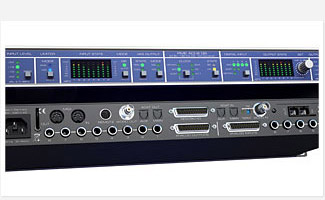FireWire 800 Hardware - Compatibility Problems
FireWire 800 Hardware - Compatibility Problems
Prior to the release of new hardware, RME carry out extensive tests not only of the hardware itself, but also of its compatibility to other hardware. When testing the Fireface 800, we found hardware errors of several manufacturers. In order to enable safe operation of the Fireface 800 for our customers, we publish the results of our tests in this Tech Info.
Glasses on!
Reassuring: FireWire 400 (1394a-2000) has always functioned properly. We tested PCI FireWire cards with chips from VIA, NEC and Texas Instruments. The communication between computer, Fireface 800 and external FireWire hard drive didn't show any problem.
Worrying: With FireWire 800 (1394b), however, we encountered shaky communication, complete denial or strong temperature dependancy. Operating the Fireface and an external FW800 hard drive at the same time caused irregular bus resets, which were of course interrupting the audio signal.
After extensively testing various devices with each other and taking a closer look at the circuits, we found that several devices on the market simply show hardware design mistakes, which can be modified in some cases, or which are irreparable in others. In most cases, it is the power supply voltage of the so-called physical chip. In the data sheet, Texas Instruments request at least 1.85 V, typically even 1.95 V. Unfortunately, TI have not emphasized this in the data sheet, and the regarding pins of the chip are called PLLVDD-1.8 and DVDD-1.8. No big surprise, that some manufacturers erroneously supply these pins with 1.8 V.
Internally, however, the 'Phy' works almost like a Gigahertz CPU. And a fact that every PC tuner knows from experience is true here as well. With an operating voltage 150 mV too low, the chip doesn't work properly anymore. Depending on the chip's revision it can be more or less problematic, but reliability is definitely being defined differently.
Faulty Hardware
The following selection has been made accidentally, depending on availability in Germany. There is no claim for completeness. We would have liked to test the FW800 PCI cards from Lindy and Trust, but they were not available at the time.
No Name 3-Port PCI-32 Bit
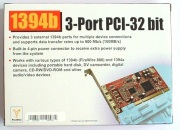
This card is available in Germany through various distributors and retailers. It has 3 FW800 ports and is one of the few 32 bit cards, which many users may probably prefer. But there are actually few rational reasons for this, because 64 bit cards also work in 32 bit PC motherboards, regarding both dimensions and electrical requirements. A statement often to be found, that such a 64 bit card would only yield FW400 performane in a 32 bit slot, is simply nonsense and most likely a translation error.
The 1394b 3-Port PCI-32 Bit shows two design mistakes. The crucial one is the voltage regulator bottom left, an LM1117-1.8. If you don't want to throw this card away, and are skilled in soldering, then you could bend pin 1 up and solder a 27 Ohm resistor between the pin and the soldering pad (ground). Doing so, the output voltage rises to 1.95 V and the physical chip works properly.
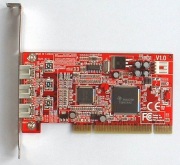
The other 'mistake' is harder to quantify, but it leaves us with a bad taste in the mouth. FireWire 800, a high frequency communication protocol close to a Gigahertz, requires an outstanding clock. TI thus specify low jitter crystals with less than 5 pico seconds of jitter. But these are expensive. Now, what could prevent one from taking a cheap 24 MHz standard crystal and boosting its output signal up to 98 MHz with an also cheap clock PLL IC? Correct, the jitter aspect. But exactly this has been done here, as one can see with the crystal at the top and the small clock PLL IC next to the left.
After modifying the voltage regulator, the card worked in our tests. But as mentioned before, we are not completely convinced.
Exsys EX-6410
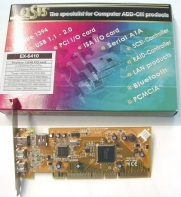
This card has two FW800 ports, one external and one internal FW400 port, which cannot be used simultaneously though. It is our present 'king of misdesign'. Instead of from a voltage regulator, the physical chip gets its supply voltage from a 1.8 V output pin of the link layer chip - modification impossible. Also clearly visible in the picture, the clock section with standard crystal and PLL IC (see also No-Name 3-port).
But the Exsys has got one more to go: The TI chipset also allows operation of its ports in FireWire 400 mode (more exact, 1394a-2000), which has been implemented here for one port. But then, this port has to be configured by applying a voltage to a special pin - which has not been done here. When a FW800 capable device (FireFace 800...) is now connected to this port, both devices try to establish a type 800 communication via type 400 sockets and cables, which is definitely bound to fail.
Alternate Speedstar
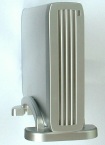
From the well-known German mail-order retailer Alternate, we bought a no-name hard disk enclosure called Speedstar (order no. T3FF05). Actually a nice and well-manufactured device. But apparently also in China, TI's unclear data sheet is not being understood correctly, because the physical chip is being fed from a 1.8 V regulator here, too.
Like with the 3-Port PCI card, the voltage can be increased to 1.95 V by inserting an additional resistor, the device works flawlessly then (has been tested).
Comment
Along these three examples, you can on one hand get an idea, what sort of traps there are on the way to a reliable and completely compatible FireWire 800 design. Further critical points are the layout, the high frequency design especially in the neighbourhood to the FW sockets, ground planes and quality of the power supply. On the other hand, a web search shows, that there are many different no-name devices available (especially outside of Germany), of which a good deal will probably have the mistakes mentioned above.
Briefly: anyone buying a device with a FireWire 800 port can not be sure that it will function properly. And: Many FW800 interfaces, especially the PCI cards, are not being used with FW800 by most users. They are used as interface to a slow (FW400) digicam. Therefore, and because of the relatively small distribution of FireWire 800 at the moment, there are no reports of compatibility issues to be found on the web.
Working Hardware
Because of the experiences described above, we recommend that all FireFace 800 users who want to use FireWire800, use only devices tested by RME. We have checked the usage of low jitter crystals, a correct supply voltage of 1.95 V and a proper function with Fireface, plus the combination of Fireface and external FW800 hard drive with the following devices.
Apple G5 Serie
It actually goes without saying, but only to avoid requests: Apple's G5 computers with FW800 port are fully compatible.
LaCie
LaCie, renowned manufacturer, delivers a good brand's quality. Both the FireWire 800 PCI Card and the external LaCie d2 Triple Interface Hard Drive are fully compatible.
IceCube
The renowned manufacturer MacPower also met our expectations. The external hard drive enclosure IceCube 800 is fully compatible.
Alternate Firewire PCI
No-name ware doesn't necessarily have to bad. For example Alternate's FireWire Card 1394b 800 PCI, a 64 bit PCI card with two FW800 and one FW400 port. The card is only 54 Euros and works very well (order no. FPFV01).
Last update: 07/28/2004
Copyright © Matthias Carstens.
All entries in this Tech Infopaper have been thoroughly checked, however no guarantee for correctness can be given. RME cannot be held responsible for any misleading or incorrect information provided throughout this document. Lending or copying any part or the complete document or its contents is only possible with the written permission from RME.

